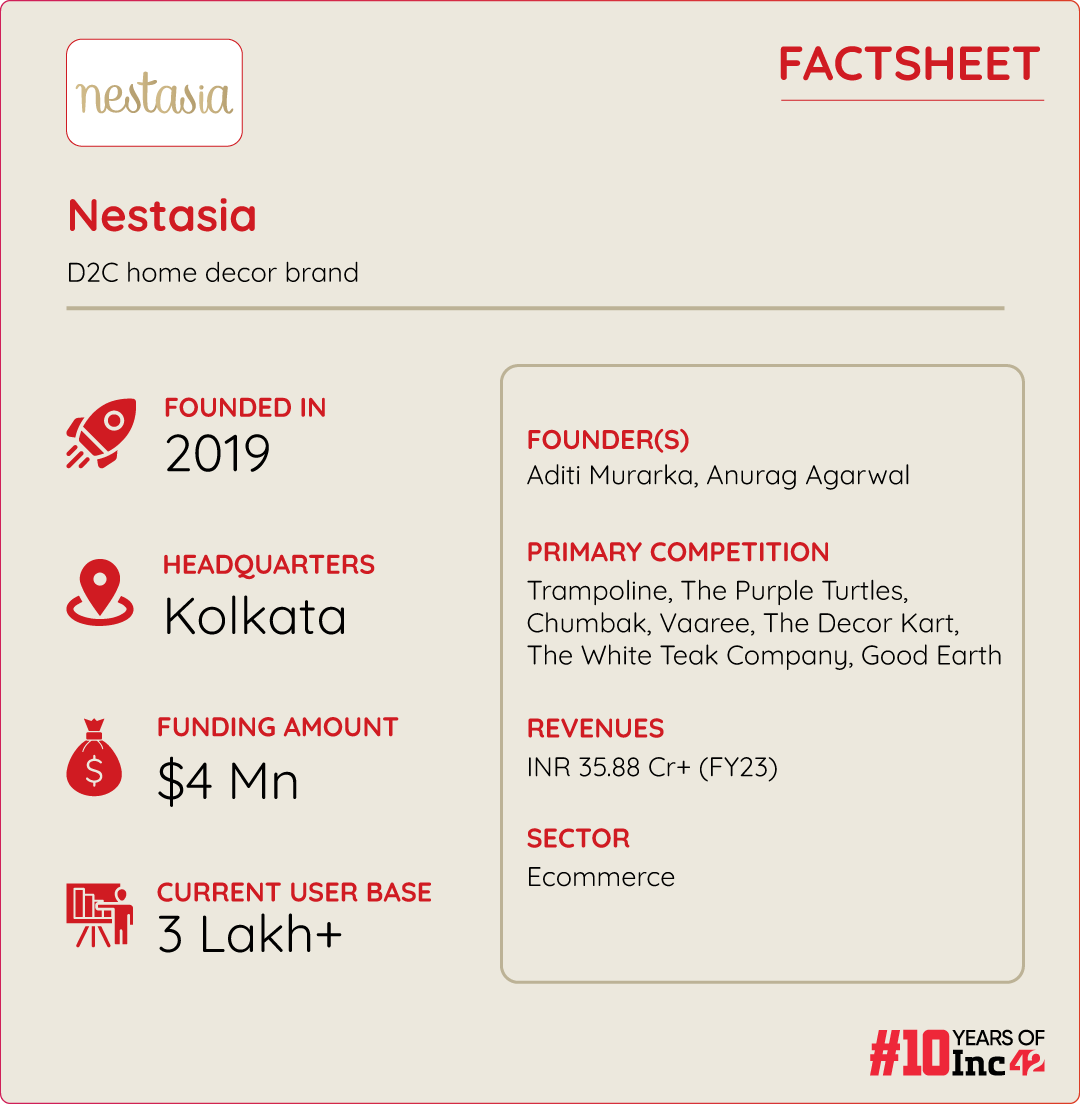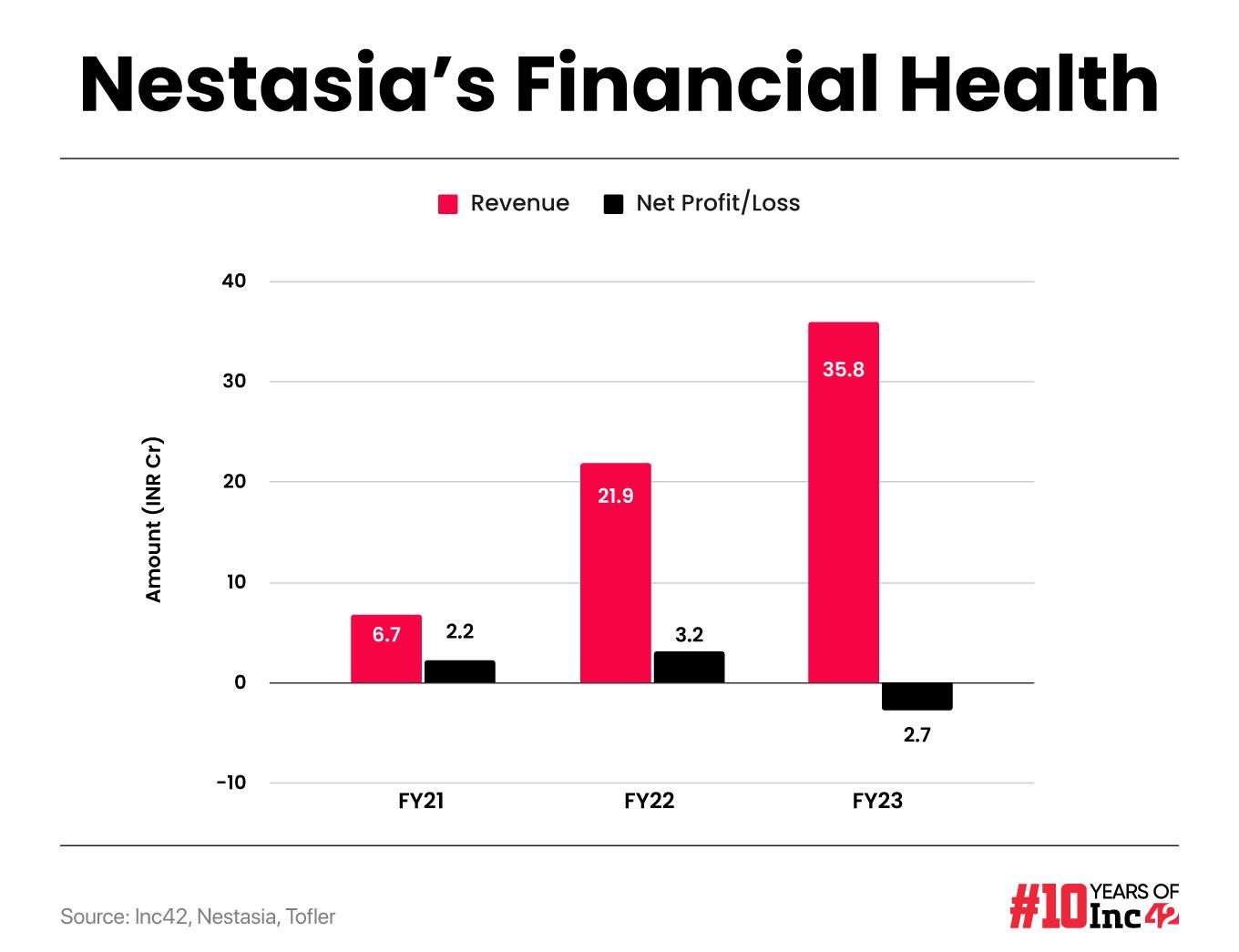Founded in 2019 by Aditi Murarka and Anurag Agarwal, Nestasia is a home decor brand, which offers products such as decor, bath, crockery, garden accessories, and kitchen utilities
The startup has raised $4 Mn from Stellaris Venture Partners, Varun Alagh of Mamaearth, Sahil Barua of Delhivery, and Livspace’s Anuj Srivastava and Ramakant Sharma
In the home decor segment, the startup competes with names such as Trampoline, The Purple Turtles, Chumbak, Vaaree, Pepperfry, Furlenco, and Urban Ladder
The home decor industry in India is undergoing a major transformation on the back of the growing D2C wave in the country. Ten years ago, when D2C wasn’t the norm, home furnishing meant buying local products or visiting premium offline stores.
Then came the online shopping spurt and brands like Pepperfry and Urban Ladder entered the fray, serving customers at the comfort of their doorsteps. But this was not enough, as these brands had an unquenchable thirst to grow, so they invested heavily in moving offline, too.
From 2018-2019 onwards, D2C brands like Trampoline, Chumbak and The Decor Kart emerged, meeting evolving consumer demands with diverse home decor solutions such as eco-friendly products, garden decor, bath essentials, kitchen utilities.
In the same league emerged Nestasia, aiming to bridge the gap between low-quality local stores and high-end boutiques by offering a fresh perspective on home adornment.
Founded in 2019 by Aditi Murarka and Anurag Agarwal, Nestasia is a home decor brand, which offers products such as decor, bath, crockery, garden accessories, and kitchen utilities.
Unlike other marketplaces, the Kolkata-based startup operates a full-fledged D2C business, buying products from Indian artisans and selling them directly to customers. It primarily sells on Amazon and Myntra and is also present on TataCliq, Pepperfry, and Nykaa.
The D2C brand generates revenue through shop-in-shops in modern trade and its own app, live on both the App Store and Play Store. It achieves 98% of its sales from digital channels and 2% from five offline stores. Its revenue is evenly split between Tier II cities and metros, with key markets in Maharashtra, Delhi NCR, and Karnataka.
Starting with 100-200 products, the D2C brand now offers about 4,500 items across six categories, fulfiling over 3 Lakh orders. According to Tofler, the company’s operating revenue increased by 63.8% from INR 21.90 Cr in FY22 to INR 35.88 Cr in FY23.
The startup has raised $4 Mn from Stellaris Venture Partners, Varun Alagh of Mamaearth, Sahil Barua of Delhivery, and Anuj Srivastava and Ramakant Sharma of Livspace.


From Changing Homes To Nestling Nestasia
Before founding Nestasia, Aditi Murarka, an XLRI Jamshedpur alumna, worked as an associate manager at ZALORA Group in Singapore, where she handled strategy and planning for the company.
Her job demanded frequent movement between Hong Kong and Singapore. And in a span of four years living outside India, she had already changed her house more times than she can remember.
However, she had always enjoyed setting up and decorating her abode. Slowly and gradually Murarka developed a deep passion for home decor products, so much so that the husband and wife duo then decided to pick this full time.
They envisioned to build a brand that offered unique, contemporary, and premium quality home decor products.
After a year of research, Murarka returned to India in 2019 to pursue her vision. In the same year, she launched Nestasia, seizing the opportunity presented by the rise of ecommerce and increasing interest in home decor.
Agarwal, who previously worked in equities trading at Goldman Sachs, joined her shortly before the Covid-19 pandemic began in early 2020.
Initially, they started with a lean team, and the husband-wife duo relied on their savings to bootstrap the venture.
Also, at the outset, the startup aimed to fill the gap in the homeware market by offering a wide variety of products. “We added a lot of SKUs because we aimed for variety. However, we realised that it wasn’t the width or variety that attracted customers but rather the quality and design of the products,” Murarka added.
So, the cofounders decided to fine-tune their assortment, reducing it from 10,000-12,000 SKUs in 2023 to around 4,500 SKUs in 2024, ensuring each product was design-driven and of high quality.
The cofounders then banked on launching home decor products for seasonal and special occasion launches. The combination of a seasonal, design-driven approach became the brand’s USP.
The Pandemic Shot In The Arm
Just four to five months after its launch, the Covid-19 pandemic struck the world. During this time, Nestasia’s supply chain took a severe hit, making it almost impossible for the cofounders to fulfil customer orders (even though few).
Now, with imports stuck and delivery services halted, the team often had to pack and ship products themselves. The gap between running out of stock and receiving replenishments was another significant challenge faced by the brand.
“To maintain customer trust, Anurag and I personally called every customer who placed an order, explaining the delays and reassuring them of eventual delivery,” Murarka said.
But, the cofounders were clever to read the market and amidst a series of challenges, they shifted their focus on crafting engaging content on social media. They started DIY projects to engage with their audience, which resulted in them building a strong social media presence.
This content-first approach led to the creation of an in-house content team that still produces high-quality content, driving about 15% of referrals and conversions from social media.
This was also the time when Nestasia achieved its first 100 orders.
Nestasia’s Product Folio
According to the cofounders, the startup today has been successful in positioning itself as a premier home and lifestyle product destination.
Offering a wide array of products, from dining ware and kitchen essentials to decor items like candles and mirrors, bath accessories, soft furnishings, and now bags and accessories, the startup aims to establish itself as the go-to destination for all things home-related.
Murarka mentioned that previously, dining and kitchen formed a single category, representing 100% of their business. However, in April 2022, with the addition of new categories, the kitchen segment swiftly transitioned to constituting 25% of their business. It currently contributes to 45% of their revenue.
Transitioning to a design-driven focus, the startup launched visually appealing lunchboxes in 2023, meeting demands for quality and aesthetics. This success prompted an expansion into other offerings like shopping bags, organisers, and vanity boxes.
Currently, the cofounders have an in-house production unit for bags and accessories in Kolkata. The startup’s bags and accessories segment accounts for approximately 18% of its total revenue.
The Road Ahead
Notably, the home decor industry is experiencing a notable shift, with the online market projected to grow to $5.4 Bn by 2025. To capitalise on this opportunity, the startup is focussing on growth strategies, including optimising product distribution, reducing logistics costs, expanding its presence across all channels, and significantly increasing offline expansion.
The startup, currently operating five stores, aims to open five more this year and reach approximately 40 stores by next year. The cofounders have already finalised deals for upcoming locations, targeting Airia Mall in Gurgaon, DLF Mall of India in Noida, and potential sites in Pune and Mumbai. To facilitate this expansion, the cofounders are experimenting with store size, assortments, and locations to enhance the customer experience.


In the home decor segment, the startup competes with companies such as Trampoline, The Purple Turtles, Chumbak, Vaaree, Pepperfry, Furlenco, and Urban Ladder.
Additionally, the startup aims to offer a seamless online-offline shopping experience by allowing customers to pick up online purchases in-store and vice versa.
The startup is also working on implementing loyalty programmes and enabling customers to place orders through their app for home delivery, enhancing convenience and flexibility for shoppers.
By increasing scale and efficiency, the startup plans to become EBITDA positive by 2025.
Looking ahead to FY25, Nestasia aims to prioritise expanding offline stores and enhancing branding efforts.
[Edited by Shishir Parasher]

